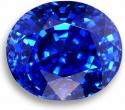September: Sapphire
September Birthstone: Sapphire
Birthstone Color: Deep Blue
Sapphire Myths & Historical Facts
There isn’t a more stunning shade of blue than the one found in a sapphire, September’s birthstone. Named after the Greek word "sapphirus", meaning blue, Sapphires have long been a favorite among priests and kings, who considered them symbolic of wisdom and purity. These gemstones are prominent among the British Crown Jewels, and Prince Charles chose this as the engagement stone for his fiancée, Princess Diana.
In ancient times, Sapphires were thought to be protective against envy, and even against poisoning. The largest and most famous sapphire is the 563-carat Star of India which can be seen in the American Museumof Natural History.
Sapphire Facts
Sapphire can be found in any blue hue imaginable. “Fancy sapphires” come in shades of pink, purple, orange, yellow, gold and green.
In ancient times, sapphires were referred to as hyacinths, specifically the blue variety. Later, their color was likened to yet another flower; the cornflower, an evocative term that is still used today and signifies a very desirable hue of blue sapphire. The word “safir” from both Hebrew and Arabic roots, means “blue,” yet sapphires come in almost every color, such as yellow, pink, green, and purple.
Sapphires belong to the corundum gemstone species as does ruby. They share virtually the same chemical composition.
Sapphire is a very durable gemstone, second only to diamond, with a hardness of 9.0 on the Mohs Hardness Scale.

